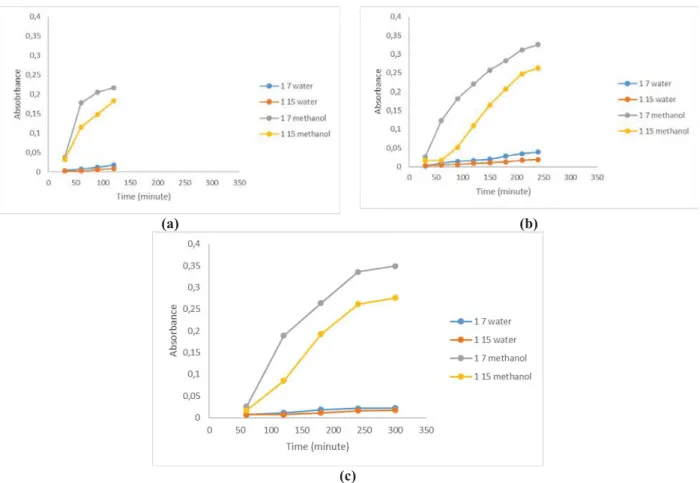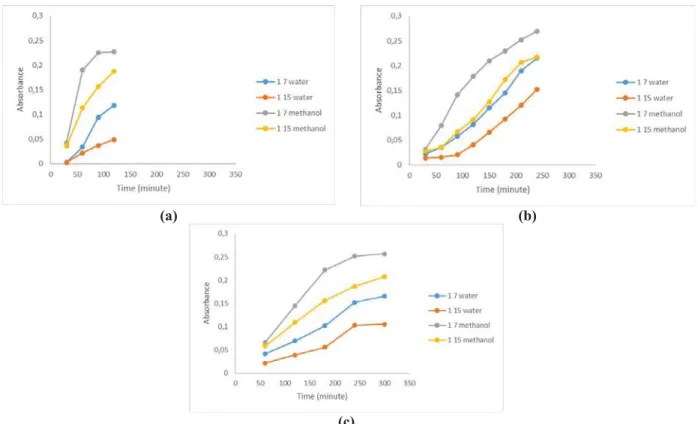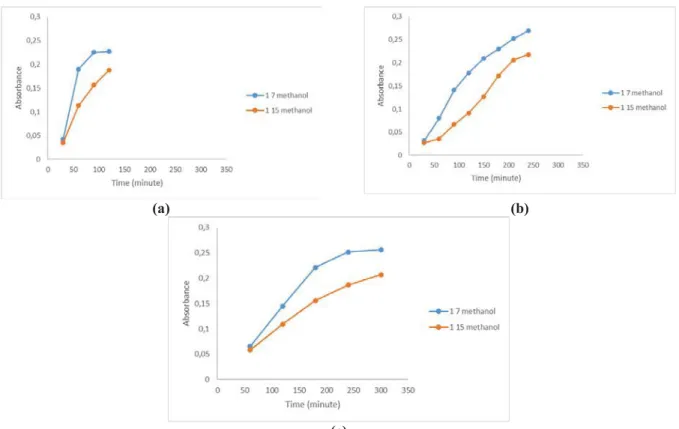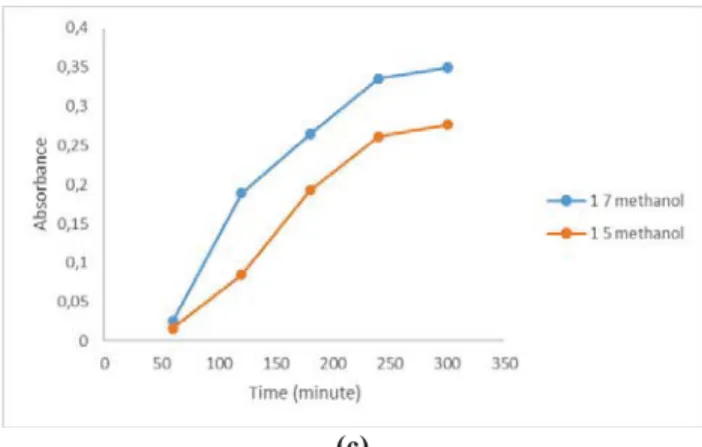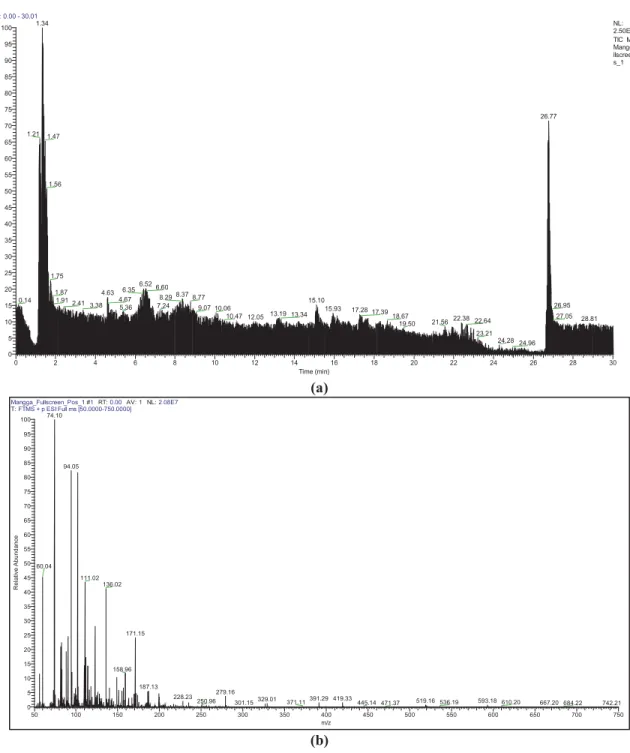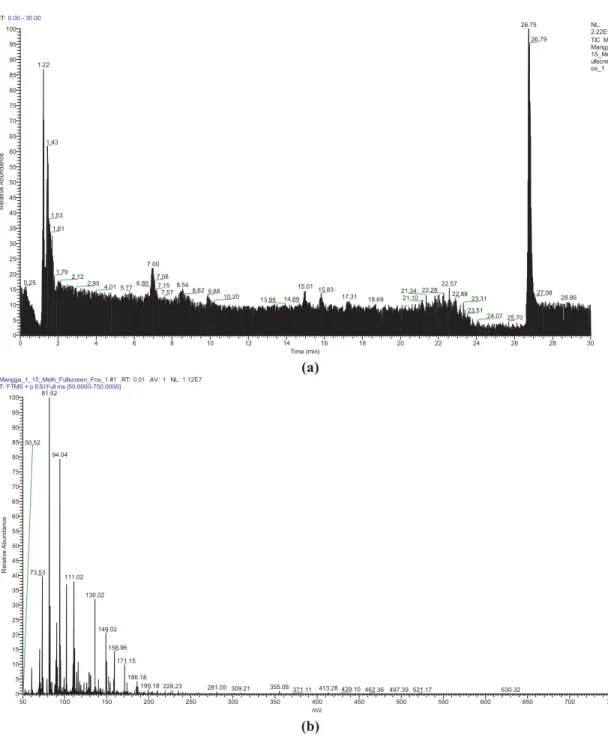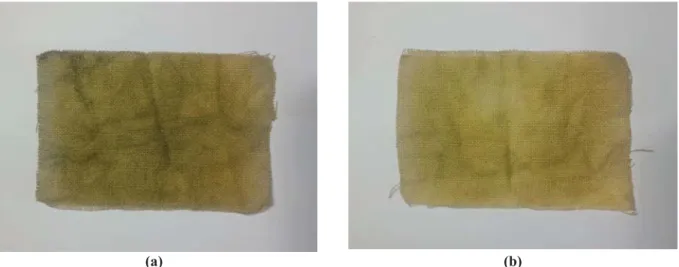! "!"#$ !%"&"
;'!
! "!"#$ !%"&"
'()*))
!"#$%&'$(")""#"*)
+) )( , - ,. - /0 1 2''/ ' )3 ))' )1/ '
! "!"#$ !%%#
4/)'') )1 '. 5!6
# ! "!"#$ !%"
7. /'.( /)3) 89742':
$" ! "!"#$ !%"&#
The Effects of Material to Solvent Ratio on the Performances of Natural Dyes Extraction
Putu Doddy Sutrisna
1,a), Meyta Sanoe
1,b), Rifando Gogo Adiyaksa
1,c), Kristina Wahyu Agustine
1,d), Hadiyatni Rita Priyantini
1,e), Prayogo Widyastoto Waluyo
2,f)and I Made Ronyastra
3,g)1Department of Chemical Engineering, Faculty of Engineering, University of Surabaya, Surabaya 60293, Indonesia
2Department of Fashion Design and Lifestyle, Faculty of Creative Industry, University of Surabaya, Surabaya 60293, Indonesia
3Department of Industrial Engineering, Faculty of Engineering, University of Surabaya, Surabaya 60293, Indonesia
a) Corresponding author: [email protected]
Abstract. The utilization of natural dyes from natural resources in fashion industry is preferred than synthetic dyes as the natural dyes is considered as more environmentally friendly than synthetic dyes. In addition, dyes from natural resources, such as plant, are renewable resources that can be sustainably used. In recent years dye from Mangifera has been used widely as sources for yellow color in fashion industry. However, there are still more studies need to investigate the effects of solvent to material ratio during extraction process to attain a standard color that can be applied in industry.
Thus, this study focused on the extraction process of dye from mangifera leaf to optimize and provide recommendation about the best solvent and the ratio of solvent to material used in the dyeing process. Experimental results showed that the best solvent for Mangifera indica extraction process is methanol. In addition, the best material to solvent ratio to obtain maximum yield was 1 : 7.
Keywords: Natural dyes, extraction, solvent, ratio
INTRODUCTION
Dyes are useful in various fields, including food and beverages, textiles, cosmetics, and household materials. The usage of color could add aesthetic value to any product [1]. Based on the sources, textile dyes could be classified into two categories: natural dyes, which are generated from plants or animals, and synthetic dyes, which are produced from chemical reaction with aromatic hydrocarbon derivatives (benzene, naphthalene, and anthracene) as the raw materials [1-2]. Excess usage of synthetic dyes could damage the environment due to its toxic waste that degraded into carcinogenic compounds [3-4]. Thus, it would also harm the other living creatures nearby. Therefore, natural dye is considered as an alternative because it is less toxic, renewable, biodegradable, and environmentally friendly [5]. Furthermore, mordant substitution by the natural dye eliminates the heavy metal content in the waste.
Common technique used for obtaining specific substances from natural plants is extraction [6]. Extraction for dyes can be conducted by using either maceration, reflux or soxhlet extractions.
International Conference on Informatics, Technology, and Engineering 2021 (InCITE 2021) AIP Conf. Proc. 2470, 040005-1–040005-10; https://doi.org/10.1063/5.0080171
Published by AIP Publishing. 978-0-7354-4180-4/$30.00
040005-1
The benign utilization of natural dyes instead of synthesized ones, as mentioned earlier increased the demand for natural coloring agents. In Indonesia, batik artisans and the yarn industries commonly use natural dyes conventionally. However, they pay less attention to the method, process condition, and materials-solvents usage.
From the previous study by Sutrisna et al. (2020) [7], the optimum method and condition for sappan bark extraction was a Soxhlet with ethanol as the solvent which produced 4.96% of yield and 0.69 of absorbance. As for the mango leaves extraction, the reflux method with water as the solvent was found to be the best way to extract yellow color with 2.52% yield and 0.48 absorbance, and the Soxhlet method with methanol as the solvent produced green color with 6.00% and 0.69 of yield and absorbance, respectively.
In this study, the material to solvent ratio of Mangifera indica (mango leaves) was observed with specific methods and conditions. A yellowish-green color from mangiferin, which is contained in Mangifera indica (mango leaves), was expected and finally shown. In addition to discovering the optimum ratio of material to solvent by yield and absorbance, the dye application for yellow color on fabrics was also investigated in this paper. Hence, further research about natural dye extraction from natural ingredients was needed to obtain a fit material to solvent ratio.
MATERIALS AND METHODS Materials
Mangifera indica leaves (Gadung species) were gathered directly from the trees planted in Surabaya, Indonesia.
The leaves were washed, sun-dried for about 4-5 days, and ground using a kitchen blender until the powder was attained. The powder was then screened to get 40/70 mesh particle size and extracted using distilled water and methanol 95% (technical grade, purchased from Brataco Chemika, Jakarta, Indonesia) as solvents.
Methods
The ratios of material to solvent 1:7 and 1:15 were used in case of each variable for Mangifera indica leaves extraction. The extraction using reflux and Soxhlet set equipment was maintained by TP-101 digital temperature indicator at 100oC on the three-neck rounded flask for distilled water, 64oC for methanol, and 79oC for ethanol following each boiling point. Samples were collected at 30 minutes intervals, filtered using filter paper Whatman Grade 40 (for reflux method), and the absorbance were measured using HP-8453 Double Beam UV-Vis Spectrophotometer at a wavelength of 463 nm for Mangifera indica leaves. Time variation was employed in three ways i.e. 2, 4, and 5 hours. The yields at the end of time variation were calculated by taking 5 ml of samples that were dried in an oven for 2 hours at 110oC. Moreover, LC-HRMS analysis was done using Thermo ScientificTM-Q ExactiveTM as the high-resolution mass spectrometer. Two solvents of 0.1% formic acid in water and 0.1% formic acid in acetonitrile were used along with Hypersil GOLD aQ 50 x 1 mm x 1.9 u particle size analytical column.
Throughout the analysis process, the column oven is maintained at 30oC. The dye application for both ratios was applied in linen cloth which had a high absorption.
040005-2
RESULTS AND DISCUSSION Mangifera indica Spectral Analysis
The absorbance data of Mangifera indica leaves extraction for each method are presented in Fig. 1 and Fig. 2, respectively.
(a) (b)
(c)
FIGURE 1. Methanol and Water Solvents Absorbance vs Time (min) Relation for (a) 2 hours; (b) 4 hours; (c) 5 hours by Soxhlet Method
The absorbance trend vs time for methanol solvent in Fig. 1 showed an increase then reached a steady state as shown in Fig. 1c for 5 hours extraction. In the case of solvent, the usage of water was not shown any significant absorbance rise compared to methanol. Thus, it is indicated that the Soxhlet method for leaves extraction was more suitable with methanol solvent. Due to methanol’s volatile characteristic and lower surface tension than water (20.21 mN/m for methanol and 58.98 mN/m for water), the extraction process in the materials’ pore was easier [7].
Furthermore, the functional groups in methanol (-OH and -CH3) could dissolve either polar or non-polar compounds which could extract the mangiferin better than water as a universal solvent [8].
Both of the solvents for mangiferin extraction by reflux method generated a high increase of absorbance along the time as shown in Fig. 2. However, methanol solvent still gave a higher absorbance than water solvent. Therefore, it can be concluded from Fig. 1 and 2 that methanol solvent produced a better performance for both extraction methods. This phenomenon happened because of the flavonoid compound that had the -OH functional group in mangiferin, which had similar polarity with the solvent. Therefore, the materials to methanol solvent ratio was further discussed.
040005-3
(a) (b)
(c)
FIGURE 2. Methanol and Water Solvents Absorbance vs Time (min) Relation for (a) 2 hours; (b) 4 hours; (c) 5 hours by Reflux Method
Materials to Solvent Ratio in Mangifera indica
The plots of the absorbance with time are shown in Figure 3 and Figure 4 for each extraction method sequentially. The materials to solvent ratio of 1:7 produced a greater absorbance value for all extraction duration as shown in Fig. 3. Moreover, a 1:7 ratio by the Soxhlet method gave an economic advantage where it only needed a small amount of solvent to dissolve the same quantity of materials.
(a) (b)
040005-4
(c)
FIGURE 3. Methanol Solvent Absorbance vs Time (min) Relation for (a) 2 hours; (b) 4 hours; (c) 5 hours by Soxhlet Method An extraction process of Mangifera indica by reflux method with methanol in Fig. 4 performed the same tendency with the Soxhlet method in Fig. 3 where 1:7 materials to solvent ratio gave higher absorbance results than the 1:15 ratio. A greater amount of solvent produced a lower absorbance because a large amount of solvent diluted the sample containing color substances.
(a) (b)
(c)
FIGURE 4. Methanol Solvent Absorbance vs Time (min) Relation for (a) 2 hours; (b) 4 hours; (c) 5 hours by Reflux Method Comparing the extraction method by methanol solvent, the Soxhlet extraction gave a better extraction result than the reflux one based on the absorbance number. It was due to continuous reflux and siphoning method resulting renewable solvent that Soxhlet method had. In addition, a Soxhlet method was more suitable with a low boiling point solvent which could easily evaporate. Thus, the extraction process by methanol generated a better performance in the Soxhlet method than the reflux method.
040005-5
Mangifera indica Yield Analysis
The yield of Mangifera indica extraction for each ratio was presented in Table 1 and Table 2.
TABLE 1. Yield Percentage of Mangifera indica Extraction by 1:7 Ratio
Method Water Solvent (%) Methanol Solvent (%)
Soxhlet ; 2 hours 0.89 2.16
Soxhlet ; 4 hours 1.22 4.1
Soxhlet ; 5 hours 1.14 3
Reflux ; 2 hours 1.41 2.51
Reflux ; 4 hours 2.08 2.72
Reflux ; 5 hours 1.71 2.54
TABLE 2. Yield Percentage of Mangifera indica Extraction by 1:15 Ratio
Method Water Solvent (%) Methanol Solvent (%)
Soxhlet ; 2 hours 0.15 1.74
Soxhlet ; 4 hours 1.14 3.7
Soxhlet ; 5 hours 0.66 2.61
Reflux ; 2 hours 1.3 1.22
Reflux ; 4 hours 1.46 2.1
Reflux ; 5 hours 1.38 2
As shown in Table 1 and Table 2, yield percentages for both extraction methods by water and methanol solvents were not proportional to the increase of extraction duration where a maximum yield was achieved at 4 hours of extraction. These results were also in line with the spectral analysis. Overall, the 1:7 materials to solvent ratio generated a greater yield value than the 1:15 ratio in every method and time of extraction.
According to Zhang et al., (2018) [9], a similar polarity between materials and solvent played a big role in the extraction success. This statement was proven by the yield percentages in Table 1 and Table 2 which a higher yield was resulted from using methanol solvent.
Mangifera indica LC-HRMS Analysis
The best extraction performance of Mangifera indica (both ratios), Soxhlet extraction by methanol solvent for 4 hours, were shown in Fig. 5 and Fig. 6 respectively. LC-HRMS analysis by scan mode was chosen to identify and quantify the compounds containing in the leaves extract.
040005-6
RT:0.00 - 30.01
0 2 4 6 8 10 12 14 16 18 20 22 24 26 28 30
Time (min) 0
5 10 15 20 25 30 35 40 45 50 55 60 65 70 75 80 85 90 95 100
Relative Abundance
1.34
26.77 1.21 1.47
1.56
1.75
6.52 6.60
1.871.91 4.634.676.35 8.298.37 8.77 15.10
0.14 2.41 3.38 5.36 7.24 9.07 10.0610.47 12.05 13.19 13.34 15.93 17.28 17.3918.6719.50 21.56 22.3822.64 26.9527.05 28.81
23.21 24.28 24.96
NL:
2.50E9 TIC MS Mangga_Fu llscreen_Po s_1
(a)
(b)
FIGURE 5. LC-HRMS Analysis of 1:7 Ratio. (a) Chromatogram; (b) Mass Spectrum
Mangga_Fullscreen_Pos_1 #1RT:0.00AV:1NL:2.08E7 T:FTMS + p ESI Full ms [50.0000-750.0000]
50 100 150 200 250 300 350 400 450 500 550 600 650 700 750
m/z 0
5 10 15 20 25 30 35 40 45 50 55 60 65 70 75 80 85 90 95 100
Relative Abundance
74.10
94.05
60.04 111.02
136.02
171.15
158.96 187.13
279.16
228.23250.96 301.15329.01 371.11391.29 419.33 445.14471.37 519.16536.19 593.18610.20 667.20 684.22 742.21
040005-7
(a)
(b)
FIGURE 6. LC-HRMS Analysis of 1:15 Ratio. (a) Chromatogram; (b) Mass Spectrum The highest 5 peaks in Fig. 5 and Fig. 6 were summarized in Table 3 and Table 4 consecutively.
TABLE 3. Mangifera indica LC-HRMS Analysis Summary for 1:7 Ratio
Compound Name Retention Time Area m/z
N-(2,6-difluorophenyl)-2-(4-
nitrophenyl) acetamide 1.34 38,054,009.88 73.3
Choline 1.47 3,459,385,491.39 104.02
Trigonelline 1.56 149,947,034.42 136.02
L-Norleucine 1.75 122,181,566.79 158.96
L-Phenylalanine 1.87 123,635,161.53 171.15
RT:0.00 - 30.00
0 2 4 6 8 10 12 14 16 18 20 22 24 26 28 30
Time (min) 0
5 10 15 20 25 30 35 40 45 50 55 60 65 70 75 80 85 90 95 100
Relative Abundance
26.75 26.79
1.22
1.43
1.53 1.61
7.00
1.792.12 7.08
0.25 2.954.01 5.776.85 7.157.578.548.629.8810.20 13.95 14.6915.0115.83 17.31 18.69 21.3421.1022.2822.5722.8823.31 27.08 28.86
23.51 24.07 25.70
NL:
2.22E9 TIC MS Mangga_1_
15_Meth_F ullscreen_P os_1
Mangga_1_15_Meth_Fullscreen_Pos_1 #1RT:0.01AV:1NL:1.12E7 T:FTMS + p ESI Full ms [50.0000-750.0000]
50 100 150 200 250 300 350 400 450 500 550 600 650 700 750
m/z 0
5 10 15 20 25 30 35 40 45 50 55 60 65 70 75 80 85 90 95 100
Relative Abundance
81.52
94.04
73.53 111.02
136.02
149.02 158.96
171.15 186.18
199.18 228.23 281.05309.21 355.08371.11 413.28429.10 50.52
462.36 497.39521.17 630.32
040005-8
TABLE 4. Mangifera indica LC-HRMS Analysis Summary for 1:15 Ratio
Compound Name Retention Time Area m/z
Choline 1.43 274,517,020.11 104.11
3-Hydroxy-2-methylpyridine 1.53 17,978,973.68 136.02
(7E,13E)-9,15-dihydroxy- 4,10,16-trimethyl-1,5,11- trioxacyclohexadeca-7,13- diene-2,6,12-trione
1.61 1,237,464,377.44 149.02
L-Norluecine 1.79 29,187,369.42 158.96
Adenosine 2.12 245,360,485.90 171.15
LC-HRMS analysis for 1:7 and 1:15 ratios indicated the same choline compound with a different retention time as shown in Table 3 and Table 4. The late detection time for choline in the 1:15 ratio was due to a minimal compound contained in the sample. The m/z values for both ratios also showed a similarity number with data from Pubchem NCBI respectively by 104.02, 104.11, and 104.10. Thus, it can be concluded that the ratio difference did not affect the content in the sample.
Mangifera indica Linen Cloth Coloring
The coloring results were shown in Figure 7 for 4 hours of Soxhlet extraction by methanol solvent.
(a) (b)
FIGURE 7. Mangifera indica Coloring Results in Linen Cloth for (a) 1:7 Ratio; (b) 1:15 Ratio
The coloring result of Mangifera indica extraction produced a darker color in thew 1:7 materials to solvent ratio (Fig. 7a) than the 1:15 ratio. The pale color in Fig. 7b might be due to the coloring agent dilution in the 1:15 materials to solvent ratio.
CONCLUSION
This research has conducted the extraction processes of yellow colour from mango leaf. The extraction process required different process conditions to optimize the yield of dyes produced. Methanol was found to be the best solvent for Mangifera indica extraction from spectrophotometer and LC-HRMS analysis. Regarding the material to solvent ratio, the 1:7 ratio showed to be the best extraction performance for both materials. The application of color into the fabric showed a promising result and further research are still required to enhance the colouring process of fashion in industrial scale.
040005-9
ACKNOWLEDGEMENTS
The authors gratefully acknowledge the funding support from The Ministry of Research and Higher Education of The Government of Indonesia under the scheme of National Research Competitive of Applied Research 2021 under contract No. 025/SP-Lit/AMD/LPPM-01/Dikbudristek/Mono/FT/VII/2021.
REFERENCES
1. S. Shinde, L. Thorat and A. Mulay, Comparative study of mangiferin from mangifera indica (rajapuri) from its leaves and bark, Int. J. Innov. Emerg. Res. Eng. 22-25 (2015).
2. J. Acosta, I. Sevilla, S. Salomon, L. Nuevas, A. Romero and D. Amaro, Determination of mangiferin solubility in solvents used in the biopharmaceutical industry, J. Pharm. Pharmacog. Res. 49-53 (2016).
3. E. Widjajanti, P.R. Tutik and M.P. Utomo, Pola adsorpsi zeolit terhadap pewarna azo metil merah dan metil jingga, Pros. Sem. Nas. Penel. Pend. Pener. MIPA, K115-K122 (2011).
4. R. Kant, Textile dyeing industry an environmental hazard, Natur. Sci. 1-5 (2012).
5. G. Yernisa and K. Syamsu, Aplikasi pewarna bubuk alami dari ekstrak biji pinang pada pewarnaan sabun transparan, J. Teknol. Ind. Perta., 23 (3), 190-198 (2013).
6. P. Setyopratomo, A. Fatmawati, P.D. Sutrisna, E. Savitri and K. Allaf, The dehydration kinetics physical properties, and nutritional content of banana textured by instantaneous controlled pressure drop, Asia Pac. J.
Chem. Eng. 7 (5) 726-732 (2012).
7. P.D. Sutrisna, R. P. Hadi, J. J. Valentina, H. R. Priyantini, P. W. Waluyo, and I M. Ronyastra, Natural dyes extraction intended for coloring process in fashion industries, IOP Conf. Series: Mater. Sci. Eng., 833, 1-5 (2020).
8. S.S. Shinde and A.R. Chavan, Isolation of mangiferin from different varieties of mangifera indica dried leaves, Int. J. Sci. Eng. Res, 5, 928-934 (2014).
9. Q.W. Zhang, L.G. Lin and W.C. Ye, Techniques for extraction and isolation of natural products: A comprehensive review, Chi. Med., 13, 20 (2018).
040005-10
INCITE 2021 PROGRAM BOOK
39
PAPER ID: PAPER 42
The Effects of Material to Solvent Ratio on The Performances of Natural Dyes Extraction
Putu Doddy Sutrisna1,a), Meyta Sanoe1,b), Rifando Gogo Adiyaksa1,c), Kristina Wahyu Agustine1,d), Hadiyatni Rita Priyantini1,e), Prayogo Widyastoto Waluyo2,f) and I Made Ronyastra3,g)
1Department of Chemical Engineering, Faculty of Engineering, University of Surabaya (UBAYA), Indonesia
2Department of Fashion Design and Lifestyle, Faculty of Creative Industry, University of Surabaya (UBAYA), Indonesia
3Department of Industrial Engineering, Faculty of Engineering, University of Surabaya (UBAYA), Indonesia
a)Corresponding author: [email protected]
The utilization of natural dyes from natural resources in fashion industry is preferred than synthetic dyes as the natural dyes is considered as more environmentally friendly than synthetic dyes. In addition, dyes from natural resources, such as plant, are renewable resources that can be sustainably used. In recent years dye from Mangifera has been used widely as sources for yellow color in fashion industry. However, there are still more studies need to investigate the effects of solvent to material ratio during extraction process to attain a standard color that can be applied in industry. Thus, this study focused on the extraction process of dye from mangifera leaf to optimize and provide recommendation
INCITE 2021 PROGRAM BOOK
40 about the best solvent and the ratio of solvent to material used in the dyeing process.
Experimental results showed that the best solvent for Mangifera indica extraction process is methanol. In addition, the best material to solvent ratio to obtain maximum yield was 1 : 7.
Keywords: Natural dyes, extraction, solvent, ratio
INCITE 2021
International Conference on Informatics, Technology and Engineering
“LEVERAGING SMART ENGINEERING”
VIRTUAL CONFERENCE GUIDE
ISSN :
in conjunction with : Organized by:
Faculty of Engineering, Universitas Surabaya
International Keynote Speakers:
Virtual Conference August 25th – 26th 2021
INCITE 2021 PROGRAM BOOK
39
PAPER ID: PAPER 42
The Effects of Material to Solvent Ratio on The Performances of Natural Dyes Extraction
Putu Doddy Sutrisna1,a), Meyta Sanoe1,b), Rifando Gogo Adiyaksa1,c), Kristina Wahyu Agustine1,d), Hadiyatni Rita Priyantini1,e), Prayogo Widyastoto Waluyo2,f) and I Made Ronyastra3,g)
1Department of Chemical Engineering, Faculty of Engineering, University of Surabaya (UBAYA), Indonesia
2Department of Fashion Design and Lifestyle, Faculty of Creative Industry, University of Surabaya (UBAYA), Indonesia
3Department of Industrial Engineering, Faculty of Engineering, University of Surabaya (UBAYA), Indonesia
a)Corresponding author: [email protected]
The utilization of natural dyes from natural resources in fashion industry is preferred than synthetic dyes as the natural dyes is considered as more environmentally friendly than synthetic dyes. In addition, dyes from natural resources, such as plant, are renewable resources that can be sustainably used. In recent years dye from Mangifera has been used widely as sources for yellow color in fashion industry. However, there are still more studies need to investigate the effects of solvent to material ratio during extraction process to attain a standard color that can be applied in industry. Thus, this study focused on the extraction process of dye from mangifera leaf to optimize and provide recommendation
INCITE 2021 PROGRAM BOOK
40 about the best solvent and the ratio of solvent to material used in the dyeing process.
Experimental results showed that the best solvent for Mangifera indica extraction process is methanol. In addition, the best material to solvent ratio to obtain maximum yield was 1 : 7.
Keywords: Natural dyes, extraction, solvent, ratio
INCITE 2021 PROGRAM BOOK
2
CONFERENCE ORGANIZER
The InCITE 2021 Organizing Comittee would like to thank the following names who has served as the:
SCIENTIFIC COMMITTEE
x Prof. Benny Tjahjono, Ph.D. (Coventry University, Coventry, England)
x Prof. Dr. Anton Satria Prabuwono (King Abdulaziz University, Jeddah, Saudi Arabia) x Prof. Dr. Ing. Ir. I Made Londen Batan M.Eng. (Institut Teknologi Sepuluh Nopember (ITS),
Surabaya, Indonesia)
x Prof. Dr. Ir. Joko Lianto Buliali (Institut Teknologi Sepuluh Nopember (ITS), Surabaya, Indonesia)
x Prof. Dr. Ir. Judy Retti B. Witono, M.App.Sc. (Universitas Katolik Parahyangan, Bandung, Indonesia)
x Prof. Dr. Ir. Wahyudi Sutopo, S.T., M.Si., IPM (Universitas Sebelas Maret, Solo, Indonesia) x Prof. Ir. Arif Djunaidy, M.Sc., Ph.D. (Institut Teknologi Sepuluh Nopember (ITS), Surabaya,
Indonesia)
x Prof. Ir. Djoko Budiyanto, M.Eng., Ph.D. (Universitas Atma Jaya, Yogyakarta, Indonesia) x Prof. Ir. Joniarto Parung, M.M.B.A.T., Ph.D. (Universitas Surabaya, Surabaya, Indonesia) x Prof. Ir. Lieke Riadi, Ph.D. (Universitas Surabaya, Surabaya, Indonesia)
x Prof. Itthisek Nilkhamhang, Ph.D. (Sirindhorn International Institute of Technology, Pathum Thani, Thailand)
x Prof. Dr. Pavel Albores (MIET, FHEA) (Aston University, Birmingham, England) x Assoc. Prof. Bertha Maya Sopha, S.T., M.Sc., Ph.D. (Universitas Gadjah Mada (UGM),
Yogyakarta, Indonesia)
x Assoc. Prof. Dina Natalia Prayogo, S.T., M.Sc. (Universitas Surabaya, Surabaya, Indonesia) x Assoc. Prof. Dr-Ing. Amalia Suzianti, S.T., M.Sc. (Universitas Indonesia (UI), Jakarta,
Indonesia)
x Assoc. Prof. Dr. A. F. M. Saifuddin Saif (American International University, Bangladesh) x Assoc. Prof. Dr. Andi Cakravastia Arisaputra Raja, S.T., M.T. (Institut Teknologi Bandung
(ITB), Bandung, Indonesia)
x Assoc. Prof. Dr. Benjawan Srisura (Assumption University of Thailand, Bangkok, Thailand) x Assoc. Prof. Dr. Diana Purwitasari, S.Kom., M.Sc. (Institut Teknologi Sepuluh Nopember
(ITS), Surabaya)
x Assoc. Prof. Dr. Dra. Amelia Santoso, M.T. (Universitas Surabaya, Surabaya, Indonesia) x Assoc. Prof. Dr. Dra. Ir. Evy Herowati, M.T. (Universitas Surabaya, Surabaya, Indonesia) x Assoc. Prof. Dr. Emma Savitri, S.T., M.Sc. (Universitas Surabaya, Surabaya, Indonesia) x Assoc. Prof. Dr. Ir. Anas Ma’ruf, M.T. (Institut Teknologi Bandung (ITB), Bandung,
Indonesia)
INCITE 2021 PROGRAM BOOK
3 x Assoc. Prof. Dr. Ir. Puguh Setyopratomo, M.T. (Universitas Surabaya, Surabaya,
Indonesia)
x Assoc. Prof. Dr. Ir. Susila Candra, M.T. (Universitas Surabaya, Surabaya, Indonesia) x Assoc. Prof. Dr. Joko Siswantoro, S.Si., M.Si. (Universitas Surabaya, Surabaya, Indonesia) x Assoc. Prof. Dr. Ludovic F. Dumee (Khalifa University, Uni Arab Emirates (UAE)) x Assoc. Prof. Dr. Mohd Sanusi Azmi (Universiti Teknikal Malaysia Melaka, Melaka) x Assoc. Prof. Dr. Ridi Ferdiana, S.T., M.T. (Universitas Gadjah Mada (UGM), Yogyakarta,
Indonesia)
x Assoc. Prof. Dr. Rosita Meitha Surjani, S.T., M.T. (Universitas Surabaya, Surabaya, Indonesia)
x Assoc. Prof. Dr.Eng. Wahyudiono (Nagoya University, Nagoya, Japan)
x Assoc. Prof. Elieser Tarigan, S.Si., M.Eng., Ph.D. (Universitas Surabaya, Surabaya, Indonesia)
x Assoc. Prof. Ir. Eric Wibisono, Ph.D., IPU. (Universitas Surabaya, Surabaya, Indonesia) x Assoc. Prof. Ir. Hanung Adi Nugroho, Ph.D. (MIEEE, MACM) (Universitas Gadjah Mada
(UGM), Yogyakarta, Indonesia)
x Assoc. Prof. Restu Kartiko Widi, S.Si., M.Si., Ph.D. (Universitas Surabaya, Surabaya, Indonesia)
x Assoc. Prof. Satvasheel Powar, Ph.D. (Dalarna University, Sweden)
x Assoc. Prof. Tan Kay Chuan, Ph.D. (National University of Singapore (NUS), Singapore) x Assoc. Prof. Teguh Bharata Adji, S.T., M.T., M.Eng., Ph.D. (Universitas Gadjah Mada
(UGM), Yogyakarta, Indonesia)
x Assoc. Prof. The, Jaya Suteja, S.T., M.Sc., Ph.D. (Universitas Surabaya, Surabaya, Indonesia)
x Assoc. Prof. Timotius Pasang, Ph.D. (Oregon Institute of Technology, USA)
x Alexander Yohan, S.Kom., M.I.M., Ph.D. (Universitas Surabaya, Surabaya, Indonesia) x Djuwari, S.T., Ph.D. (Universitas Surabaya, Surabaya, Indonesia)
x Dr. Awang Hendrianto Pratomo (UPN “Veteran” Yogyakarta, Indonesia) x Dr. Delta Ardy Prima, S.ST., M.T. (Universitas Surabaya, Surabaya, Indonesia) x Dr. Drs. Muhammad Rosiawan, M.T. (Universitas Surabaya, Surabaya, Indonesia) x Dr. Fredy Purnomo, S.Kom, M.Kom. (Universitas Bina Nusantara, Jakarta, Indonesia) x Dr. Hazrul Iswadi, S.Si., M.Si. (Universitas Surabaya, Surabaya, Indonesia)
x Dr. Hendri Himawan Triharminto (Akademi Angkatan Udara, Yogyakarta, Indonesia) x Dr. Indri Hapsari, S.T., M.T. (Universitas Surabaya, Surabaya, Indonesia)
x Dr. Jimmy, S.T., M.I.S. (Universitas Surabaya, Surabaya, Indonesia)
x Dr. Khoiruddin, S.T., M.T. (Institut Teknologi Bandung (ITB), Bandung, Indonesia) x Dr. Mohamad Rezi bin Abdul Hamid (University Putra Malaysia, Seri Kembangan,
Malaysia)
x Dr. Naniek Utami Handayani, S.Si., M.T. (Universitas Diponegoro, Semarang, Indonesia)
INCITE 2021 PROGRAM BOOK
4 x Dr. Yenny Sari, S.T., M.Sc. (Universitas Surabaya, Surabaya, Indonesia)
x Firman Kurniawansyah, S.T., M.Eng.Sc., Ph.D. (Institut Teknologi Sepuluh Nopember (ITS), Surabaya)
x Nemuel Daniel Pah, S.T., M.Eng., Ph.D. (Universitas Surabaya, Surabaya, Indonesia) x Ratna Surya Alwi, S.T., M.Si. Ph.D. (Universitas Fajar, Makassar, Indonesia) x Drs. Heru Arwoko, M.T. (Universitas Surabaya, Surabaya, Indonesia)
x Hendi Wicaksono Agung Darminto, S.T., M.T. (Universitas Surabaya, Surabaya, Indonesia) x Liliana, S.T., M.MSI. (Universitas Surabaya, Surabaya, Indonesia)
x Maya Hilda Lestari Louk, S.T., M.Sc. (Universitas Surabaya, Surabaya, Indonesia) x Mohammad Farid Naufal, S.Kom., M.Kom. (Universitas Surabaya, Surabaya, Indonesia) x Monica Widiasri, S.Kom., M.Kom. (Universitas Surabaya, Surabaya, Indonesia)
x Vincentius Riandaru Prasetyo, S.Kom., M.Cs. (Universitas Surabaya, Surabaya, Indonesia) x Yuana Elly Agustin, S.T., M.Sc. (Universitas Surabaya, Surabaya, Indonesia)
x Yunus Fransiscus, S.T., M.Sc. (Universitas Surabaya, Surabaya, Indonesia)
INCITE 2021 PROGRAM BOOK
5 STEERING COMMITTEE
Chair: Asst. Prof. Putu Doddy Sutrisna, S.T., M.Sc., Ph.D.
Honorary
Members: Prof. Ir. Joniarto Parung, M.M.B.A.T., Ph.D.
Prof. Ir. Lieke Riadi, Ph.D.
Members: Assoc. Prof. Ir. Eric Wibisono, Ph.D., IPU
Assoc. Prof. Ir. Markus Hartono, S.T., M.Sc., Ph.D.
Assoc. Prof. Djuwari, S.T., Ph.D.
Assoc. Prof. Dr. Dra. Amelia Santoso, M.T.
Asst. Prof. Nemuel Daniel Pah, S.T., M.Eng., Ph.D.
Assoc. Prof. Dr. Emma Savitri, S.T., M.Sc.
Assoc. Prof. Elieser Tarigan, S.Si., M.Eng., Ph.D.
Assoc. Prof. Jaya Suteja, S.T., M.Sc., Ph.D.
Assoc. Prof. Ir. Hudiyo Firmanto, M.Sc., Ph.D.
Assoc. Prof. Restu Kartiko Widi, S.Si., M.Si., Ph.D.
Assoc. Prof. Dr. Joko Siswantoro, S.Si., M.Si.
Assoc. Prof. Dr. Indri Hapsari, S.T., M.T.
Asst. Prof. Susilo Wibowo, S.T., M.Eng.
Asst. Prof. Arum Soesanti, S.T., M.T.
ORGANIZING COMMITTEE
Chair: Asst. Prof. Dr. Jimmy, S.T., M.I.S.
Vice Chair: Asst. Prof. Yuwono Budi Pratiknyo, S.T., M.T.
Secretariat: Ms. Liliana, S.T., M.MSI.
Mr. Marcellinus Ferdinand Suciadi, S.T., M.Comp.
Treasurers: Ms. Rafina Destiarti Ainul, S.ST., MT.
Program: Ms. Maya Hilda Lestari Louk, S.T., M.Sc.
Mr. Herman Susanto, S.T.,M.Sc.
Website: Mr. Daniel Soesanto, S.T., M.M.
Mr. Felix Handani, S.Kom., M.Kom.
Design: Ms. Tryza Adelia, S.Sn., M.Inf.Tech.
INCITE 2021 PROGRAM BOOK
6 InCITE 2021 ORGANIZING COMMITTEE:
FACULTY OF ENGINEERING, UNIVERSITAS SURABAYA DEAN BUILDING TB 2, RAYA KALIRUNGKUT
SURABAYA, 60293, INDONESIA
PHONE: +62-31-2981150, FAX: +62-31-2981151 EMAIL: [email protected]
WEBSITE:
https://incite.ubaya.ac.id
http://teknik.ubaya.ac.id
INCITE 2021 PROGRAM BOOK
7 PREFACE
WELCOME FROM InCITE 2021 ORGANIZING COMMITTEE
Welcome to InCITE 2021! The third bi-annual international conference on engineering domain conducted by the Faculty of Engineering, The University of Surabaya (UBAYA).
Due to the COVID-19 pandemic, InCITE 2021 is held as an online conference. Online conference opens the opportunity for many researchers around the globe to share their findings and learn from other global researchers with less restrictions.
InCITE 2021 invites three keynote speakers, well reputable global researchers in their research domain from Australia and Taiwan. Following each keynote session are two presentation sessions run in parallel.
This year, we received 66 papers submitted by researchers from four distinct countries (i.e., first author’s country of origin): Indonesia, Australia, Taiwan, and Kazakhstan.
We employed a double-blind review to ensure a high standard and a minimum level of bias in the reviewing processes. This resulted in 56% of the submissions were accepted and will be published to the AIP Conference Proceedings.
Authors of all accepted papers are to disseminate their findings during InCITE 2021 conference between 25 to 26 of August 2021. This presents a great opportunity for everyone, including the researchers, to discuss and further improve current achievements.
We thank all keynote speakers, presenters, and reviewers/scientific committees for the generous supports. We thank the University of Surabaya, the Faculty of Engineering UBAYA, and all InCITE 2021 committees that enable InCITE 2021.
We wish you a very pleasant and rich conference experience in InCITE 2021 and looking forward to seeing you again on InCITE 2023! Thank you.
Yours sincerely, Asst. Prof. Dr. Jimmy
InCITE 2021 Organizing Committee
INCITE 2021 PROGRAM BOOK
8
INVITED SPEAKERS
Dr. Ahmed Mourad
Postdoctoral Research Fellow
Information Engineering Lab (IELAB) University of Queensland
AUSTRALIA
Prof. Chuan-Kai Yang, Ph.D Professor
Information Management
National Taiwan University of Science and Technology TAIWAN
Dr. Anton van der Vegt Postdoctoral Research Fellow
EMPOWER, a Joint Venture between Queensland Health &
the University of Queensland
University of Queensland
AUSTRALIA
INCITE 2021 PROGRAM BOOK
9
ACKNOWLEDGMENT
International Conference on Informatics, Technology and Engineering 2021 (InCITE 2021)
Organizing Committee wishes to express its gratitude and appreciation to:
Dr. Ir. Benny Lianto, MMBAT., Rector of Universitas Surabaya for consenting to be the guest of honour
All invited speakers session, moderators and conference speakers, for their participation
All conference sponsors, supporters, exhibitors and advertiser for their generous support
All participants and other who have in one way or another contributed towards the success of this conference
INCITE 2021 PROGRAM BOOK
10
KEYNOTE SPEAKERS
Dr. Ahmed Mourad
Dr. Ahmed Mourad is a Postdoctoral Research Fellow at the Information Engineering Lab (ielab), University of Queensland. His current research focuses on Conversational Systems in the context of Agricultural domain. AgAsk is a conversational agent that will provide access to agricultural R&D output (which is currently locked away into project reports, communications and scientific publications) leading directly to better, data- driven growing decisions. Through machine learning driven question-answering systems, AgAsk will elicit and understand growers information needs and preferences, providing contextualised access to insights in agricultural R&D.
He completed his PhD in Computer Science at RMIT University in 2019 under the supervision of Professor Mark Sanderson, Professor Falk Scholer and Associate Professor Walid Magdy. His research focused on the Influence of geographic biases on geolocation prediction in Twitter. Before the PhD, He worked as a Research Assistant at Qatar Computing Research Institute (QCRI) focusing on Information Retrieval and Sentiment Analysis on Arabic datasets. He also worked as a Software Engineer at large corporates including Microsoft and Mentor Siemens.
INCITE 2021 PROGRAM BOOK
11
Prof. Chuan-Kai Yang, Ph.D
Prof. Chuan-Kai Yang, Ph.D received his Ph.D. degree in
computer science from Stony Brook University, USA, in
2002, and his M.S. and B.S. degree in computer science
and in mathematics from National Taiwan University in
1993 and 1991, respectively. He served as the chairman
for the department of information management, National
Taiwan University of Science and Technology, Taiwan,
from 2017 to 2019, and is currently a Professor in the
department. His research interests include computer
graphics, scientific visualization, multimedia systems, and computational
geometry. He has published over hundreds of research papers, including more
than 30 SCI journal papers and more than 40 international conference papers.
INCITE 2021 PROGRAM BOOK
12
Dr. Anton van der Vegt
Anton completed his PhD in Information Retrieval from The University of Queensland, co-sponsored by CSIRO.
His reserach investigated the impact of time and knowledge constraints on the ability of clinicians to make high quality clinical decisions in the context of using a search engine to support this task. Anton proposed a minimal interaction framework, as an alternative to the traditional SERP (Search Engine Results Page) approach to clinical search. As a result of his research, numerous papers have been published in high ranking journals such as JASIST, JMLA and JDOC.
Prior to his PhD studies, Anton spent four years working in the UK, supporting
the implementation of the National Programme for IT into the NHS; this included
development and installation of clinical and administrative software systems to
connect patient care across the UK. Through this work he developed a much
better understanding of the unique challenges faced by clinicians and public
healthcare organisations when implementing such systems. This experience,
together with his thesis research informs his current role as PostDoctoral Research
Fellow with EMPOWER, a Joint Venture between Queensland Health and the
University of Queensland. The purpose of this JV is to create a scalable platform
for clinicians to access intelligent information to improve clinical outcomes
across Queensland.
INCITE 2021 PROGRAM BOOK
13
ACTIVITY DETAILS
Place and date of event August 25th – 26th, 2021 Location: Virtual Meeting
Day 1: Wednesday, August 25th 2021 (Time Zone: (GMT+7:00) Jakarta)
From To Activities Venue
08.00 08.30 Registration Main Virtual Room
08.30 08.45
Opening Ceremony:
Welcome Speech By Rector of Universitas Surabaya: Dr. Ir. Benny Lianto, MMBAT
Main Virtual Room
08.45 09.15 Keynote Session 1 Dr. Ahmed Mourad
(University of Queensland, AUSTRALIA) Main Virtual Room 09.15 09.45 Keynote Session 1 Closing + Photo Session Main Virtual Room
09.45 10.00 Break -
10.00 12.05 Parallel Session 1 Virtual Breakout Room
12.05 13.00 Break -
13.00 13.30
Keynote Session 2 Prof. Chuan-Kai Yang, Ph.D
(National Taiwan University of Science and Technology, TAIWAN)
Main Virtual Room 13.30 14.00 Keynote Session 2 Closing + Photo Session Main Virtual Room
14.00 14.15 Break -
14.15 16.20 Parallel Session 2 Virtual Breakout Room
16.20 16.30 Closing Day I Main Virtual Room
Day 2: Thursday, August 26th 2021 (Time Zone: (GMT+7:00) Jakarta)
From To Activities Venue
08.00 08.30 Registration Main Virtual Room
08.30 09.00
Keynote Session 3 Dr. Anton van der Vegt
(University of Queensland, AUSTRALIA) Main Virtual Room 09.00 09.30 Keynote Session 3 Closing + Photo Session Main Virtual Room
09.30 10.00 Break -
10.00 12.05 Parallel Session 3 Virtual Breakout Room
12.05 13.00 Break -
13.00 14.40 Parallel Session 4 Virtual Breakout Room
14.40 15.05 Awarding Session and Closing Ceremony Main Virtual Room
INCITE 2021 PROGRAM BOOK
14
Schedule on Parallel Session
PARALLEL SESSION 1
Venue: Virtual Meeting – Breakout Room Suro Session Chair: Alexander Yohan
No. From To Paper
ID Author Paper Title
1. 10.00 10.25 43 Joko Siswantoro, Ida Bagus Made Artadana and M. Z. F.
N. Siswantoro
Automatic Leaf Geometric Properties Measurement Based on Camera Parameters
2. 10.25 10.50 20 Vincentius Riandaru Prasetyo
and Anton Hendrik Samudra Hate Speech Content Detection System on Twitter using K-Nearest Neighbor Method
3. 10.50 11.15 30 Mohammad Farid Naufal and
Selvia Ferdiana Kusuma Weather Image Classification using Convolutional Neural Network with Transfer Learning
4. 11.15 11.40 33 Daniel Prasetyo Implementing Directed Pairwise Judgement Approach in Web-based AHP Survey Application to Reduce Inconsistency Ratio
5. 11.40 12.05 29 Yenny Sari, Vincentius Riandaru Prasetyo and Kevin Liyansah
Designing a Recommender System based on the Application of Decision Tree Algorithm in Data Mining with KNIME
Venue: Virtual Meeting – Breakout Room Boyo Session Chair: Esti Dwi Rinawiyanti
No. From To Paper
ID Author Paper Title
1. 10.00 10.25 63 Eric Wibisono, Iris Martin
and Dina Natalia Prayogo Genetic Algorithm with Adaptive Diversification and Intensification for the Vehicle Routing Problem
2. 10.25 10.50 23
Senapati C. Adisasmito, Pradipta Deffinika Pamungkas and Anas Ma'Ruf
Real-time Monitoring Design for Make-To-Order Industry
3. 10.50 11.15 44 Gunawan Community Mobility during Covid-19 Pandemic and
Tourism Performance: Data Mining Approach 4. 11.15 11.40 35 Hans Tanto, Hanijanto
Soewandi and Indriati Bisono
Simple Heuristics for Scheduling Apache Airflow: A Case Study at PT. X
INCITE 2021 PROGRAM BOOK
15 PARALLEL SESSION 2
Venue: Virtual Meeting – Breakout Room Suro Session Chair: Eric Wibisono
No. From To Paper
ID Author Paper Title
1. 14.15 14.40 15 Markus Hartono Kansei Engineering and Product-Service Systems (KEPSS) for Customer-centered Experience 2. 14.40 15.05 28 Indra Setiawan and
Hernadewita
Reducing Lead Time of Production Process Using Integration Value Stream Mapping and Kaizen: A Case Study in the Side Board Division 3. 15.05 15.30 39 Esti Dwi Rinawiyanti, Xueli
Huang and Sharif As-Saber
Integration of Corporate Social Responsibility for Improved Business Performance: Evidence from the Indonesian Manufacturing Industry
4. 15.30 15.55 55 Noverta Putra, Indri Hapsari
and Dina Prayogo Inventory System Improvement for Short-lived Item 5. 15.55 16.20 38
Hibarkah Kurnia, Choesnul Jaqin and Humiras Hardi Purba
Quality Improvement with PDCA Approach and Design of Experiment Method in Single Socks Industry in Indonesia
Venue: Virtual Meeting – Breakout Room Boyo Session Chair: Emma Savitri
No. From To Paper
ID Author Paper Title
1. 14.15 14.40 42
Putu Doddy Sutrisna, Meyta Sanoe, Rifando Gogo Adiyaksa, Kristina Wahyu Agustine, Hadiatni Rita Priyantini, Prayogo Widyastoto Waluyo and I Made Ronyastra
The Effects of Material to Solvent Ratio on The Performances of Natural Dyes Extraction
2. 14.40 15.05 56 Rezha Rachmady, Ari Rahman and
Wahyu Kunto Wibowo Textile Wastewater Purification Using Corona Discharge Method 3. 15.05 15.30 10 Lieke Riadi, Ruth Chrisnasari,
Joshua Kristanto, Cahaya Caesar Brigavida and Meyta Sanoe
Immobilization of Xylanase on Acid Pretreatment Bentonite as Green Biocatalyst
4. 15.30 15.55 41 Lanny Sapei, Rudy Agustriyanto, Endang Wahyu Fitriani, Zerravym Levy and Cindy Sumampouw
Rice Husk Ash for the Stabilization of the Outer Interfacial Layer of W/O/W Double Emulsion
5. 15.55 16.20 54 Delyana Ratnasari, Widiyastuti
Widiyastuti and Heru Setyawan One-Step Electrochemical Synthesis of Silica-coated Magnetite Nanofluids
INCITE 2021 PROGRAM BOOK
16
PARALLEL SESSION 3
Venue: Virtual Meeting – Breakout Room Suro
Session Chair: Joko SiswantoroNo. From To Paper
ID Author Paper Title
1. 10.00 10.25 46 Alexander Yohan, Nai- Wei Lo and Kevin Valentino
A Design of Secure Supply Chain Management System with Blockchain Technology 2. 10.25 10.50 27 Susana Limanto, Endah
Asmawati and Yusuf Wira Kencana Putra
School Finder, Intelligent Recommendation System for Elementary School Selection
3. 10.50 11.15 58 Andre Andre and Marcellinus Ferdinand Suciadi
The Online Attendance System Models for Educational Institutions
4. 11.15 11.40 36 Elieser Tarigan Simulation of Impact Azimuth Angle on Specific Energy Output of a Fixed Mounting Rooftop PV System in Jakarta, Indonesia
5. 11.40 12.05 65 Christabel Parung and
Prayogo Waluyo Users’ Perception of Digital Prototypes in Indonesian Fashion Industry: A Qualitative Study
Venue: Virtual Meeting – Breakout Room Boyo Session Chair: Putu Doddy Sutrisna
No. From To Paper
ID Author Paper Title
1. 10.00 10.25 34 Puguh Setyopratomo and Lanny Sapei
Rheological Behavior and Antioxidant Activity of Carrageenan Extracted from Green Seaweed (Eucheuma cottonii) Using Alkaline Solution at Low Temperature
2. 10.25 10.50 49
Marta Devega Yuharma, Widiyastuti Widiyastuti, Ni Made Intan Putri Suari and Heru Setyawan
A Performance Study of Magnetite-Lignin Composites as Photothermal Materials in Solar Steam Generation System
3. 10.50 11.15 50
Diana Novita Sari, Mahardika F. Rois, Widiyastuti Widiyastuti and Heru Setyawan
Organosolv Lignin from Coir Fibers as Potential Biomaterials for Sunscreen
4. 11.15 11.40 53 Ratri Sekaringgalih, Widiyastuti Widiyastuti and Heru Setyawan
The Effect of Sodium Lauryl Sulfate on Silica Nanofluid Stabilization Using Microbubble Method
5. 11.40 12.05 60 Emma Savitri Synthesis and Characterization of Chitosan- Allium Sativum Film
INCITE 2021 PROGRAM BOOK
17 PARALLEL SESSION 4
Venue: Virtual Meeting – Breakout Room Suro Session Chair: Christabel Parung
No. From To Paper
ID Author Paper Title
1. 13.00 13.25 32 Jimmy Jimmy and Vincent Riandaru Prasetyo
Sentiment Analysis on Feedback of Higher Education Teaching Conduct: An Empirical Evaluation of Methods
2. 13.25 13.50 26 Md. Hazrat Ali Recent advances and application of Selective Laser Melting (SLM) in the aerospace industry 3. 13.50 14.15 25
Rudy Agustriyanto, Puguh Setyopratomo and Endang Srihari Mochni
Dynamic Study of Batch Milk Cooling Process at KUD SAE Pujon
4. 14.15 14.40 31 Ellysa Tjandra, Sri Suning Kusumawardani and Ridi Ferdiana
Student Performance Prediction in Higher Education: A Comprehensive Review
Venue: Virtual Meeting – Breakout Room Boyo Session Chair: Elieser Tarigan
No. From To Paper
ID Author Paper Title
1. 13.00 13.25 52 Delta Ardy Prima Implementation of Behavior Tree for Creating an In- Game Cut-Scene
2. 13.25 13.50 45
Putu Padmareka Deandra, Herry Santoso and Judy Retti B. Witono
Carbon Based Sulfonated Catalyst as an Environment Friendly Material: A Review
3. 13.50 14.15 9
Yu-Chung Tsao, Felix Arril Simbara Barus and Chien- Wei Ho
How energy efficiency, smart factory, and mass personalization affect companies in Industry 4.0
4. 14.15 14.40 18
Yoni Kristiawan, Edi Purwanto, and Rustono Farady Marta
The Role of Supply Chain Performance to Determine the Firm Performance
ϭ͘ ƵŬƚ
Ϯ͘ ƵŬƚ
ƚŝ/KWWƌŽĐĞĞ
ƚŝĂƌƚŝŬĞůĚĂůĂ
ĞĚŝŶŐ^ĐŽƉƵƐ
ĂŵŚĂůĂŵĂŶ
ƐĚĂůĂŵŚĂůĂ
^ĐŽƉƵƐƉĞŶ
ĂŵĂŶǁĞďƐŝƚ
ŶƵůŝƐ͗
ƚĞ^ĐŝŵĂŐŽũƌƌ͘ĐŽŵ
ϯ͘ ƵŬƚ
ϰ͘ ŽƉLJ
ƚŝĞŵĂŝůƉĞŶĞ
LJŚĂůĂŵĂŶǁ
ĞƌŝŵĂĂŶĚĂƌŝ
ǁĞďƐŝƚĞLJĂŶŐ
ŝĚŝƚŽƌ:ŽƵƌ
ŵĞŵƵĂƚƉĂ ŶĂů
ĂƉĞƌ
